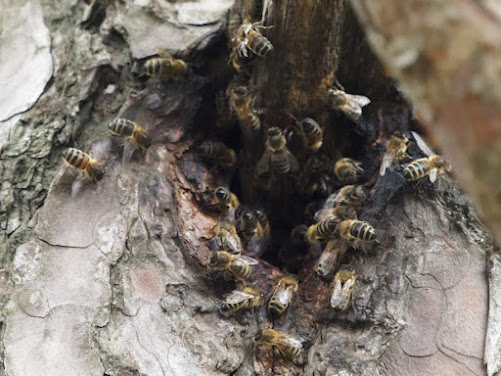On
a hot and beautiful day, we started out from the car park heading south-west
through the woodland towards the footbridge over the Beaulieu River. Before we
had even got a few yards an inquisitive Southern Hawker was flying around in
front of us.
As
we walked through the woodland, we got sidetracked by a Speckled Wood flying
around and occasionally perching in the sunlight, Enchanter’s Nightshade
and Common Dog Violet.
 |
| Enchanter's Nightshade © Richard Coomber |
On
reaching the footbridge, we found some fungi on a tree and a fallen rotten log
– we identified Common Earthball, the wonderfully named Dog Vomit Slime Mold, a
red fungus that is possibly Beechwood Sickener and, identified by Richard
Coomber, Stemonitis axifera.
 |
| Dog's Vomit Slime Mould © Kevin Tubb |
 |
| Stemonitis axifera © Richard Coomber |
Once
we crossed the footbridge and left the woodland, we found areas of Least Water
Pepper. Heading out over the heath we could see that Starpole Pond still had
water in it despite the recent hot and dry weather. There were a few
dragonflies flying around it, but they were all Common Darter apart from one
Blue Emperor.
We
then proceeded to explore the small hill where we found large numbers of Marsh
Gentian (lots in flower, some in bud and a few that had gone over). Butterflies
included Small Heath, a tatty Holly Blue,
Red Admiral and Small Copper. Fungi included HollySpeckle,
The Blusher, Brown Birch Bolete and possible Iodine Bolete.
 |
| Marsh Gentian © Richard Coomber |
 |
Brown Birch Bolete © Kevin Tubb
|
 |
| possibly The Blusher © Kevin Tubb |
 |
| possibly Iodine Bolete © Kevin Tubb |
Flora
included Devil’s Bit Scabious, Mouse-eared Hawkweed, Cat’s-ear, Autumn Hawkbit,
Dwarf Gorse, Eyebright sp, Tormentil and Chamomile.
Birds
were scarce except for a few Meadow Pipits and Wood Pigeons but that soon
changed! Firstly, we picked up lots of House Martins high up in the sky, Common
Buzzard, Common Kestrel, Common Stonechat, Eurasian Sparrowhawk, Common Linnet
and best of all a European Honey Buzzard which was calling constantly and
eventually the leader managed to get it in the telescope which was quite difficult
as the sky was clear - so no clouds to get bearings on.
We
then headed back to the car park and didn’t see anything new apart from a
fly-by Brimstone. KT





























